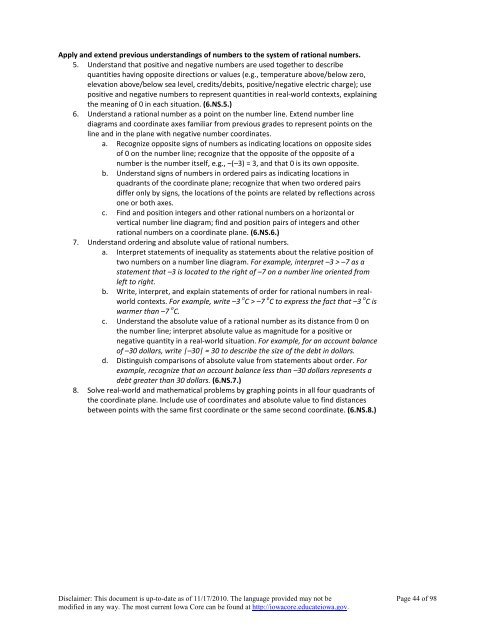Iowa Core K-12 Mathematics (PDF) - Green Hills AEA
Iowa Core K-12 Mathematics (PDF) - Green Hills AEA
Iowa Core K-12 Mathematics (PDF) - Green Hills AEA
You also want an ePaper? Increase the reach of your titles
YUMPU automatically turns print PDFs into web optimized ePapers that Google loves.
Apply and extend previous understandings of numbers to the system of rational numbers.<br />
5. Understand that positive and negative numbers are used together to describe<br />
quantities having opposite directions or values (e.g., temperature above/below zero,<br />
elevation above/below sea level, credits/debits, positive/negative electric charge); use<br />
positive and negative numbers to represent quantities in real-world contexts, explaining<br />
the meaning of 0 in each situation. (6.NS.5.)<br />
6. Understand a rational number as a point on the number line. Extend number line<br />
diagrams and coordinate axes familiar from previous grades to represent points on the<br />
line and in the plane with negative number coordinates.<br />
a. Recognize opposite signs of numbers as indicating locations on opposite sides<br />
of 0 on the number line; recognize that the opposite of the opposite of a<br />
number is the number itself, e.g., –(–3) = 3, and that 0 is its own opposite.<br />
b. Understand signs of numbers in ordered pairs as indicating locations in<br />
quadrants of the coordinate plane; recognize that when two ordered pairs<br />
differ only by signs, the locations of the points are related by reflections across<br />
one or both axes.<br />
c. Find and position integers and other rational numbers on a horizontal or<br />
vertical number line diagram; find and position pairs of integers and other<br />
rational numbers on a coordinate plane. (6.NS.6.)<br />
7. Understand ordering and absolute value of rational numbers.<br />
a. Interpret statements of inequality as statements about the relative position of<br />
two numbers on a number line diagram. For example, interpret –3 > –7 as a<br />
statement that –3 is located to the right of –7 on a number line oriented from<br />
left to right.<br />
b. Write, interpret, and explain statements of order for rational numbers in realworld<br />
contexts. For example, write –3 o C > –7 o C to express the fact that –3 o C is<br />
warmer than –7 o C.<br />
c. Understand the absolute value of a rational number as its distance from 0 on<br />
the number line; interpret absolute value as magnitude for a positive or<br />
negative quantity in a real-world situation. For example, for an account balance<br />
of –30 dollars, write |–30| = 30 to describe the size of the debt in dollars.<br />
d. Distinguish comparisons of absolute value from statements about order. For<br />
example, recognize that an account balance less than –30 dollars represents a<br />
debt greater than 30 dollars. (6.NS.7.)<br />
8. Solve real-world and mathematical problems by graphing points in all four quadrants of<br />
the coordinate plane. Include use of coordinates and absolute value to find distances<br />
between points with the same first coordinate or the same second coordinate. (6.NS.8.)<br />
Disclaimer: This document is up-to-date as of 11/17/2010. The language provided may not be Page 44 of 98<br />
modified in any way. The most current <strong>Iowa</strong> <strong>Core</strong> can be found at http://iowacore.educateiowa.gov.
















